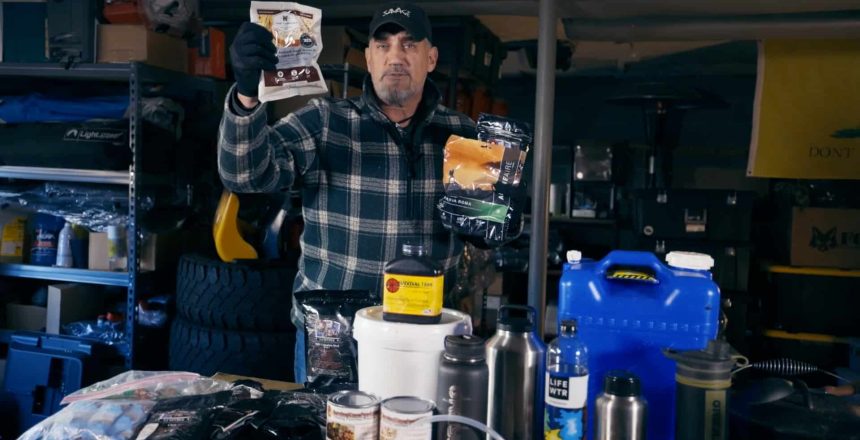Wilderness Food Preservation

Wilderness Food Preservation: Essential Techniques for Long-Term Survival
Learn the best techniques for preserving food in the wilderness to ensure long-term food security and survival, including dehydration, fermentation, pickling, freezing, canning, and primitive cooking methods.
Importance of Food Preservation in Wilderness Survival
Food preservation is critical to wilderness survival, ensuring that essential food supplies last in challenging environments. In a survival scenario, all food is susceptible to spoilage due to mold, bacteria, and insects if exposed to moisture and warm temperatures, highlighting the significance of effective preservation techniques.
The potential risks of not preserving food in the wild are substantial, as spoiled food can lead to malnutrition, illness, and even death. This underscores the crucial need to prolong the shelf life of food in such environments.
For instance, in the event of a major disaster or during an extended wilderness expedition, access to fresh food is limited, making it essential to preserve food effectively to ensure a sustainable food supply. The significance of food preservation in wilderness survival cannot be overstated, as it directly impacts the well-being and resilience of individuals in challenging outdoor environments.
Common Food Preservation Techniques for Wilderness Food
Various methods of food preservation, such as smoking meats, dehydration, fermentation, vinegar pickling, freezing, canning, and more, play a pivotal role in extending the shelf life of food in the wild. These techniques ensure a sustainable food supply and address survival challenges in wilderness environments.
For example, dehydration is a low-cost and space-efficient method that can store many foods, including fruits, vegetables, and meat. This makes it indispensable for off-grid living and long-term wilderness survival, especially when traveling and expelling a lot of calories. Understanding the versatility and benefits of dehydration allows individuals to prepare and preserve essential food supplies that are lightweight, nutrient-rich, and suitable for long-term storage in the wild.
Fermentation and vinegar pickling offer valuable methods for preserving food without conventional refrigeration or freezing. These techniques not only prolong the shelf life of food but also enhance its flavor and nutritional value.
By emphasizing the diverse applications and benefits of fermentation and pickling, individuals can expand their knowledge and skill set in preserving various foods, thus bolstering their food security when off the grid.
In addition to the fundamental preservation techniques, exploring unique and lesser-known methods, such as oil preservation, brining, smoking, curing, and lye, unveils a spectrum of possibilities for wilderness food preservation. These special techniques, backed by historical significance and practicality, offer alternative approaches to extending the shelf life of perishable food items in challenging outdoor environments.
By incorporating these diverse preservation methods, individuals can build a comprehensive toolkit for preserving and preparing food in the wild, ensuring their readiness for various survival scenarios and wilderness food preservation.
Primitive Cooking Methods for Preserving and Preparing Food in the Wilderness
Primitive cooking methods play a crucial role in preserving and preparing food for long-term sustenance in a wilderness survival scenario. These traditional techniques, such as smoking, salting, drying, and sun-drying food, have been employed for centuries and continue to be valuable skills for wilderness survival.
For example, smoking is an ancient preservation method that imparts unique flavors to food and acts as a preservative by inhibiting the growth of bacteria and mold, extending the shelf life of meat and fish. Understanding the historical significance and practicality of smoking as a preservation method allows individuals to leverage this technique to maintain a sustainable food supply in the wild.
Similarly, salting has been a widely used preservation technique throughout history. By coating meat or fish with salt, moisture is drawn out, and bacteria are inhibited from growing, effectively preserving the food. Salting can significantly prolong the edibility of perishable food items without modern refrigeration or freezing methods in the context of wilderness survival.
By delving into these primitive cooking methods, individuals can acquire essential skills for preserving and preparing food in the wild, thus enhancing their self-reliance and resilience in challenging outdoor environments.
Exploring Preservation Techniques: Dehydration
Dehydration is a crucial food preservation technique for long-term food storage. It offers a cost-effective and space-efficient method of storing essential food supplies for extended periods. This preservation method involves removing moisture from food, thereby inhibiting the growth of mold, bacteria, and insects that can lead to spoilage.
Understanding the process and benefits of dehydration is essential for individuals seeking to prolong the shelf life of various foods, including fruits, vegetables, and meat. It also makes it a practical and suitable option for off-grid sustainability when catching or harvesting foods you plan to eat over time.
For example, fruits such as apples and bananas and vegetables like carrots and bell peppers can be dehydrated to create lightweight, nutritious snacks that are ideal for wilderness expeditions. Additionally, lean cuts of meat can be dehydrated to produce jerky, a protein-rich and long-lasting food source that has been a staple in survival kits for generations.
Exploring Preservation Techniques: Canning
Canning is a crucial method for preserving non-acidic foods in the wild, allowing for long-term storage of various food items such as vegetables, soups, stews, and meats. By utilizing a water bath or pressure canning, individuals can ensure the safety and edibility of these foods without the need for conventional refrigeration or freezing.
For example, vegetables like green beans, carrots, and potatoes can be effectively canned to extend their shelf life and provide essential nutrients during long-term off-grid stays and wilderness food preservation.
Tips for Storing and Preserving Food in the Wild
When it comes to storing and preserving food in the wild, several practical tips can significantly impact the safety and edibility of preserved food in wilderness survival situations. One effective method is using beeswax wraps, which provide a natural and reusable way to store food. These wraps are made from cotton infused with beeswax, tree resin, and jojoba oil, creating a breathable and protective seal around food items, such as fruits, vegetables, cheese, and bread.
The pliable wraps can be molded around food or dishes, making them an excellent alternative to plastic wrap or aluminum foil. This method not only helps in preserving food but also reduces waste by promoting sustainable and eco-friendly practices.
Another valuable tip for food preservation in the wild is waxing. Coating certain food items, especially cheeses, with wax can serve as a protective barrier against mold and bacteria, extending their shelf life. This method involves dipping the cheese in melted wax to create a sealed layer that prevents moisture and air from reaching the cheese, thus preserving its freshness and flavor.
Waxing can also be used to preserve fruits such as apples, providing a protective layer that helps maintain their quality and prevents spoilage. This traditional technique has been utilized for centuries and is a reliable method for preserving food in the wild, especially in the absence of modern refrigeration.
Furthermore, preserving meat in lard is a time-honored method used by various cultures throughout history. Lard, which is rendered pork fat, can create a protective layer around meat, preventing exposure to air and inhibiting the growth of bacteria. This method helps preserve the meat and adds flavor and moisture, enhancing its overall quality.
By submerging meat in lard and storing it in a cool, dark place, individuals can extend the shelf life of meat without needing conventional refrigeration. Using lard for meat preservation provides a valuable alternative for wilderness food storage, especially in environments where other preservation methods may be impractical or unavailable.
These practical tips are essential for ensuring the safety and longevity of food supplies in the wild, making them indispensable skills for wilderness survival.
Special Preservation Techniques
In addition to more commonly known preservation methods, unique techniques have historically proven valuable in wilderness survival scenarios. For example, oil, brining, smoking, curing, and lye can effectively preserve meat and fish without conventional refrigeration or freezing. Smoking and curing have been practiced for centuries and are still widely used today due to their ability to extend meat and fish’s shelf life while enhancing their flavors.
Another interesting preservation technique is water glassing, which involves preserving fresh eggs in a water and sodium silicate solution. This method can keep eggs fresh for several months, providing a valuable source of protein in a wilderness survival situation where refrigeration is unavailable.
Moreover, preserving dairy products can be challenging, but turning milk into butter or cheese offers a practical solution for prolonging the shelf life of dairy in the wild. For example, cheese can be coated in wax or buried in wood ashes to protect it from spoilage and extend its usability.
These special preservation techniques demonstrate the resourcefulness and adaptability crucial for wilderness food preservation. By exploring and understanding these alternative methods, individuals can enhance their ability to secure and store food for extended periods, contributing to their overall survival in the wild.
Conclusion
Preserving food in a wilderness survival situation is paramount to ensure a sustainable food supply. Without proper food preservation techniques, all food is susceptible to spoilage, posing significant risks to a survivalist’s food sources. In a wilderness setting, survival challenges are numerous, and food storage and preservation expertise become essential for long-term sustenance.
Ultimately, mastering food preservation techniques is an invaluable skill for individuals venturing into the wilderness, providing them with the means to secure essential food supplies and sustain themselves in the face of adversity. By embracing a comprehensive approach to wilderness food preservation, individuals can enhance their readiness and resilience, ensuring their ability to thrive in challenging outdoor environments.
